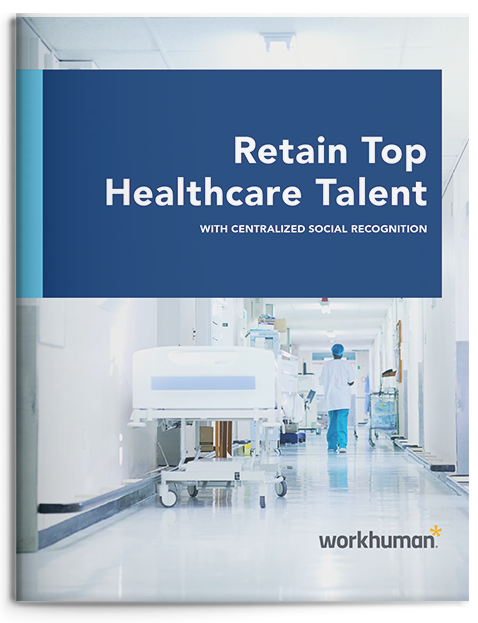

10 Tips for Boosting Retention and Performance in Healthcare
MAY 19, 2017 by Sarah Payne
Anyone who has worked in healthcare, or has family and friends in the field, knows that it takes a special kind of person to thrive in a healthcare setting. Healthcare workers are driven by a genuine desire to care for people. They’re often in high-pressure situations, working long shifts during weekends and holidays.
So it’s no surprise that turnover is one of the biggest issues facing healthcare organizations today. In a recent Leaders for Today (LFT) survey of nearly 900 healthcare workers, 37% of respondents said they plan to leave their current hospital in the next two years. Another 69% plan to leave in the next five years.
And yet fixing the turnover dilemma – by attracting and retaining highly engaged workers – is one of the biggest areas of opportunity in healthcare. A new report from Press Ganey shows strong links between employee engagement and key healthcare outcomes:
- Healthcare systems in the top quartile for physician engagement had lower rates for most hospital-acquired infections than those in the bottom quartile; they also had shorter stays, fewer readmissions, better hospital-acquired condition (HAC) scores, and lower Patient Safety and Adverse Events Composite (PSI 90) scores.
- Organizations with more highly engaged nurses also perform better across safety and composite measures than those with fewer highly engaged nurses.
- Organizations with top-quartile physician and employee engagement have better scores across HCAHPS domains than those with bottom-quartile engagement.
Roseann Kobialka, assistant vice president of organizational development at AtlantiCare, echoed this research in a recent interview with Globoforce: “We have always found when our employee engagement scores go up, our patient satisfaction goes up, as well as our physicians’ satisfaction, so all of those things move in tandem.”
What are some tangible ways healthcare organizations can enhance the employee experience and motivate their people? We explored this question in a joint research study conducted by Globoforce’s WorkHuman Research Institute and the IBM® Smarter Workforce Institute. You can read the full report here: The Employee Experience of Healthcare Workers.
The bottom line? Healthcare workers who have a positive experience at work are much more likely to give discretionary effort (which is great for patient satisfaction scores). They’re also more than 2x less likely to want to leave the organization.
Below are 10 takeaways from the report on how to drive more positive and human employee experiences in healthcare:
- Be honest. When employees agree their organization acts with integrity, 84% report a more positive employee experience vs. only 47% when they do not agree.
- Foster relationships. When employees agree co-workers help each other if needed, 81% report a more positive employee experience vs. only 46% when they do not agree.
- Be true to your values. When employees agree their work is consistent with their organization’s core values, 81% report a more positive employee experience vs. only 36% when they do not agree.
- Leverage strengths. When employees agree their job makes good use of their skill and abilities, 82% report a more positive employee experience vs. only 34% when they do not agree.
- Recognize good work. When employees agree they receive recognition when doing good work, 85% report a more positive employee experience vs. only 47% when they do not agree.
- Give continuous feedback. When employees agree they receive feedback on work performance, 81% report a more positive employee experience vs. only 49% when they do not agree.
- Encourage feedback. When employees agree their ideas and suggestions matter, 87% report a more positive employee experience vs. only 43% when they do not agree.
- Empower. When employees agree they have the freedom to decide how to do their work, 83% report a more positive employee experience vs. only 49% when they do not agree.
- Be flexible. When employees agree their work schedule is flexible enough for them to meet family/personal responsibilities, 80% report a more positive employee experience vs. only 60% when they do not agree.
- Encourage work/life balance. When employees agree they have the chance to recharge when not at work, 82% report a more positive employee experience vs. only 57% when they do not agree.
To read the full report on the impact and drivers of a more human healthcare organization, click here.

10 Tips for Boosting Retention and Performance in Healthcare
MAY 19, 2017 by Sarah Payne
Anyone who has worked in healthcare, or has family and friends in the field, knows that it takes a special kind of person to thrive in a healthcare setting. Healthcare workers are driven by a genuine desire to care for people. They’re often in high-pressure situations, working long shifts during weekends and holidays.
So it’s no surprise that turnover is one of the biggest issues facing healthcare organizations today. In a recent Leaders for Today (LFT) survey of nearly 900 healthcare workers, 37% of respondents said they plan to leave their current hospital in the next two years. Another 69% plan to leave in the next five years.
And yet fixing the turnover dilemma – by attracting and retaining highly engaged workers – is one of the biggest areas of opportunity in healthcare. A new report from Press Ganey shows strong links between employee engagement and key healthcare outcomes:
- Healthcare systems in the top quartile for physician engagement had lower rates for most hospital-acquired infections than those in the bottom quartile; they also had shorter stays, fewer readmissions, better hospital-acquired condition (HAC) scores, and lower Patient Safety and Adverse Events Composite (PSI 90) scores.
- Organizations with more highly engaged nurses also perform better across safety and composite measures than those with fewer highly engaged nurses.
- Organizations with top-quartile physician and employee engagement have better scores across HCAHPS domains than those with bottom-quartile engagement.
Roseann Kobialka, assistant vice president of organizational development at AtlantiCare, echoed this research in a recent interview with Globoforce: “We have always found when our employee engagement scores go up, our patient satisfaction goes up, as well as our physicians’ satisfaction, so all of those things move in tandem.”
What are some tangible ways healthcare organizations can enhance the employee experience and motivate their people? We explored this question in a joint research study conducted by Globoforce’s WorkHuman Research Institute and the IBM® Smarter Workforce Institute. You can read the full report here: The Employee Experience of Healthcare Workers.
The bottom line? Healthcare workers who have a positive experience at work are much more likely to give discretionary effort (which is great for patient satisfaction scores). They’re also more than 2x less likely to want to leave the organization.
Below are 10 takeaways from the report on how to drive more positive and human employee experiences in healthcare:
- Be honest. When employees agree their organization acts with integrity, 84% report a more positive employee experience vs. only 47% when they do not agree.
- Foster relationships. When employees agree co-workers help each other if needed, 81% report a more positive employee experience vs. only 46% when they do not agree.
- Be true to your values. When employees agree their work is consistent with their organization’s core values, 81% report a more positive employee experience vs. only 36% when they do not agree.
- Leverage strengths. When employees agree their job makes good use of their skill and abilities, 82% report a more positive employee experience vs. only 34% when they do not agree.
- Recognize good work. When employees agree they receive recognition when doing good work, 85% report a more positive employee experience vs. only 47% when they do not agree.
- Give continuous feedback. When employees agree they receive feedback on work performance, 81% report a more positive employee experience vs. only 49% when they do not agree.
- Encourage feedback. When employees agree their ideas and suggestions matter, 87% report a more positive employee experience vs. only 43% when they do not agree.
- Empower. When employees agree they have the freedom to decide how to do their work, 83% report a more positive employee experience vs. only 49% when they do not agree.
- Be flexible. When employees agree their work schedule is flexible enough for them to meet family/personal responsibilities, 80% report a more positive employee experience vs. only 60% when they do not agree.
- Encourage work/life balance. When employees agree they have the chance to recharge when not at work, 82% report a more positive employee experience vs. only 57% when they do not agree.
To read the full report on the impact and drivers of a more human healthcare organization, click here.
Learn how gratitude and recognition improve retention, boost performance and increase staff engagement.

